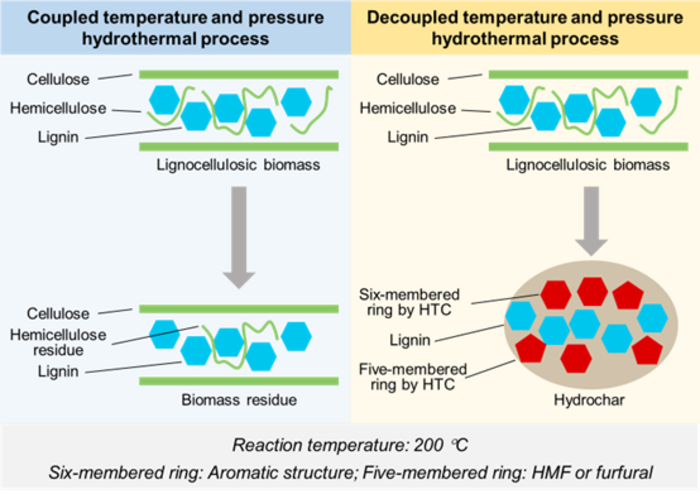Hydrothermal carbonization of lignocellulosic biomass—the most abundant renewable feedstock—is a promising method for the production of carbon materials with negative carbon emissions. This method has attracted a great deal of attention over the past decade because it uses water which is inherently present in green biomass and non-toxic.

Credit: THE AUTHORS
Hydrothermal carbonization of lignocellulosic biomass—the most abundant renewable feedstock—is a promising method for the production of carbon materials with negative carbon emissions. This method has attracted a great deal of attention over the past decade because it uses water which is inherently present in green biomass and non-toxic.
Nonetheless, like everything, hydrothermal carbonization also has its drawbacks—the requirement of high reaction temperature and high energy consumption. To that end, researchers worldwide are actively investigating greener alternatives—a team of researchers from Tsinghua University in China may just have the answer.
The team discovered a new strategy to decouple the temperature and pressure hydrothermal process, which in turn allows the breaking of the temperature limit.
“Using this new approach, we can achieve low-temperature carbonization of lignocellulosic biomass comprising rice straw and poplar leaves at 200 °C—breaking the temperature limit of 230 °C in the conventional process,” says Hui Zhou, corresponding author of the study.
The team demonstrated that the new decoupled temperature and pressure hydrothermal process could break through the protective barrier formed by the highly ordered crystalline structure of cellulose and effectively carbonize cellulose and hemicellulose, producing carbon microspheres with high calorific value, abundant oxygen-containing functional groups, a certain degree of graphitization and good thermal stability.
Cellulose is a key precursor for the formation of carbon microspheres in addition to the protective barrier of biomass structure, and biomass with high cellulose content had a higher potential for the production of well-shaped hydrochar, which can be use as a solid fuel, a soil amendment or an adsorbent for removing pollutants from wastewater streams.
The team’s findings are in the KeAi journal Green Energy & Environment.
Notably, up until now, the approach to improving reaction conditions for biomass conversion has been more in the development of new catalysts; however, there are very few catalysts suitable for hydrothermal carbonization of biomass.
“This new carbon-negative technology can greatly improve the advantages of hydrothermal carbonization technology,” adds study lead author Shijie Yu. “We hope that our results will encourage researchers worldwide to continue their research on hydrothermal carbonization of various types of biomass to contribute to the mitigation of the current climate crisis.”
###
Contact the corresponding author: Hui Zhou, Department of Energy and Power Engineering, Tsinghua University, Beijing 100084, P.R. China
Email: [email protected]
LinkedIn: https://www.linkedin.com/in/zhouh/
Twitter: @Hui_Zhou1
The publisher KeAi was established by Elsevier and China Science Publishing & Media Ltd to unfold quality research globally. In 2013, our focus shifted to open access publishing. We now proudly publish more than 100 world-class, open access, English language journals, spanning all scientific disciplines. Many of these are titles we publish in partnership with prestigious societies and academic institutions, such as the National Natural Science Foundation of China (NSFC).
Journal
Green Energy & Environment
DOI
10.1016/j.gee.2023.01.001
Method of Research
Experimental study
Subject of Research
Not applicable
Article Title
Breaking the temperature limit of hydrothermal carbonization of lignocellulosic biomass by decoupling temperature and pressure
COI Statement
The authors declare that they have no known competing financial interests or personal relationships that could have appeared to influence the work reported in this paper.




